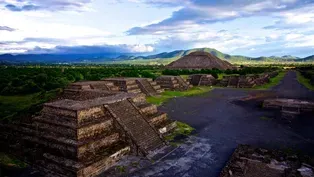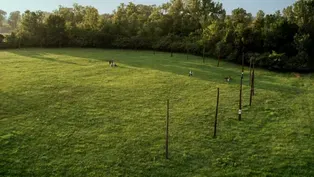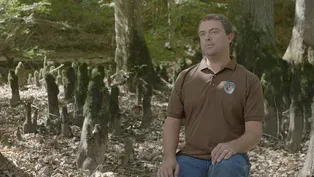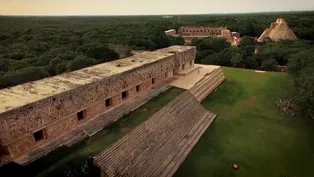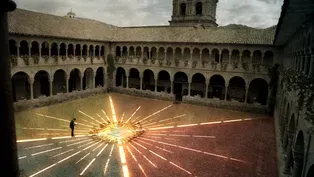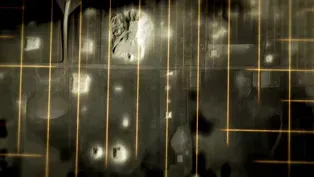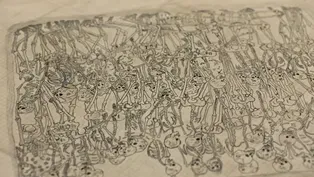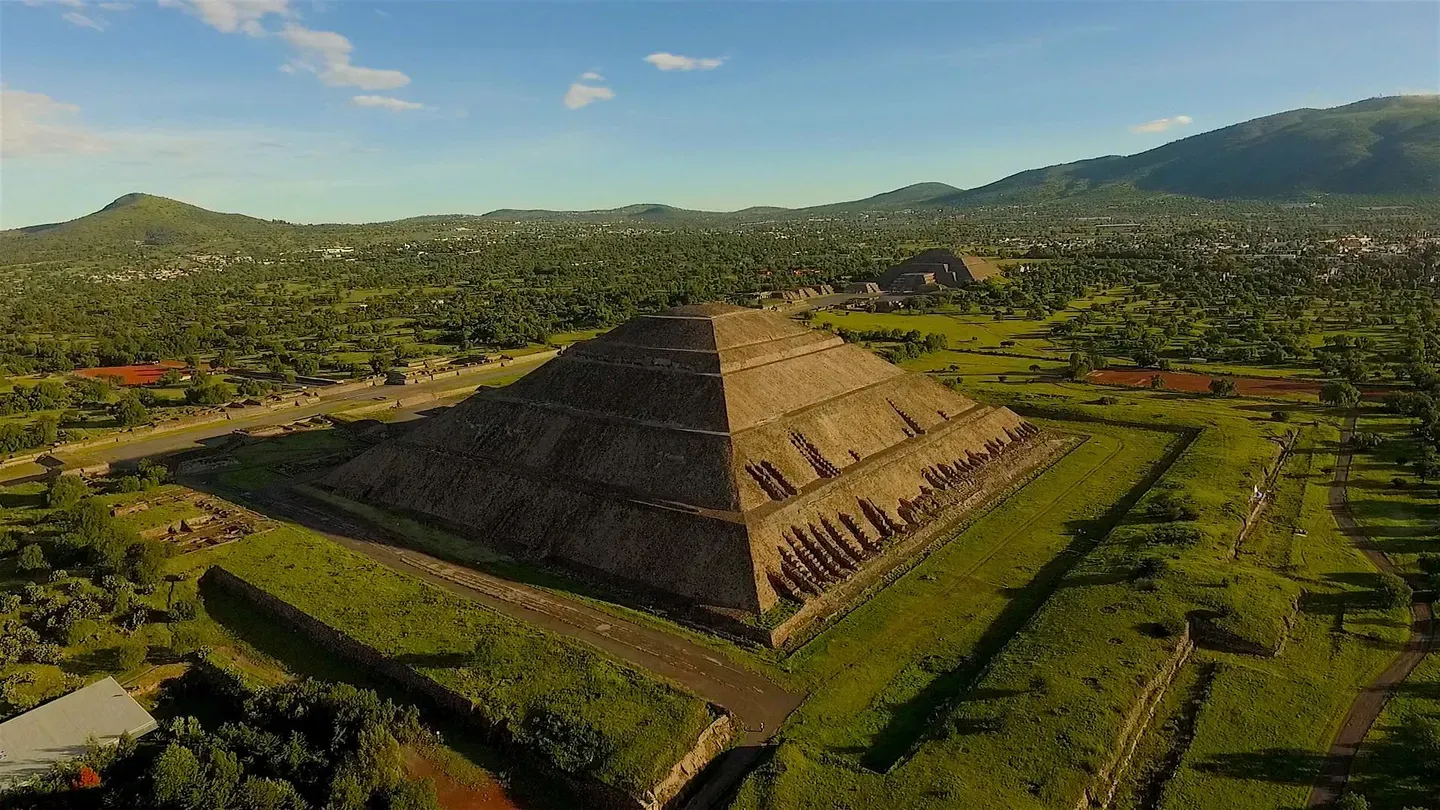

Cities of the Sky
11/13/2018 | 53m 30sVideo has Audio Description, Closed Captions
Discover the cosmological secrets behind America’s ancient cities.
Discover the cosmological secrets behind America’s ancient cities. Scientists explore some of the world’s largest pyramids and 3D-scan a lost city of monumental mounds on the Mississippi River; native elders reveal ancient powers of the sky.
See all videos with Audio DescriptionADProblems with Closed Captions? Closed Captioning Feedback
Problems with Closed Captions? Closed Captioning Feedback
Funding is provided by Partnership with Native Americans.

Cities of the Sky
11/13/2018 | 53m 30sVideo has Audio Description, Closed Captions
Discover the cosmological secrets behind America’s ancient cities. Scientists explore some of the world’s largest pyramids and 3D-scan a lost city of monumental mounds on the Mississippi River; native elders reveal ancient powers of the sky.
See all videos with Audio DescriptionADProblems with Closed Captions? Closed Captioning Feedback
How to Watch Native America
Native America is available to stream on pbs.org and the free PBS App, available on iPhone, Apple TV, Android TV, Android smartphones, Amazon Fire TV, Amazon Fire Tablet, Roku, Samsung Smart TV, and Vizio.
Buy Now
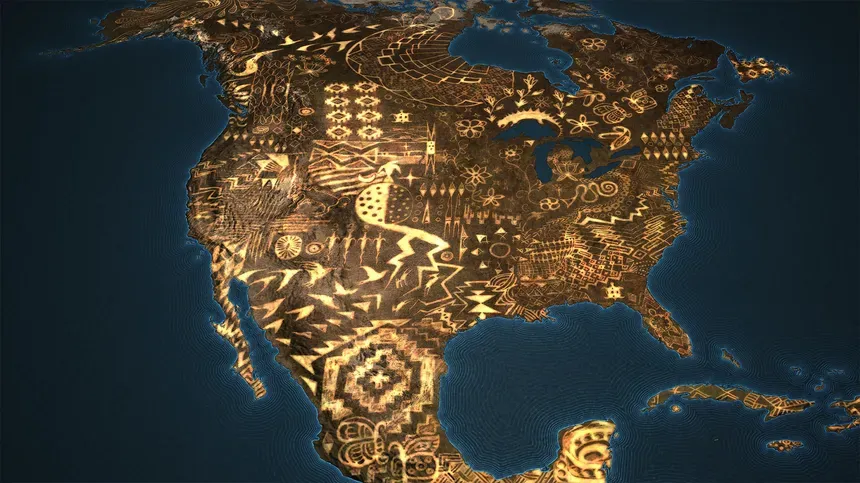
Listen to Native Voices
Explore an interactive map, which features speakers of Native languages in their own voices from across North America.Providing Support for PBS.org
Learn Moreabout PBS online sponsorshipNARRATOR: America, more than 500 years ago.
100 million people live in some of the greatest civilizations on Earth, connected by social networks spanning continents.
(chanting) NARRATOR: They build monumental cities.
And in some, as a sacred ritual, they perform human sacrifice.
♪ ♪ DAVID CARRASCO: Human beings have to make blood offerings so that the gods then will release into the world the powers to recreate life.
♪ ♪ NARRATOR: One of the biggest cities is in the middle of the United States.
Barely mentioned in textbooks, its true name is lost to history.
Today, it's called Cahokia.
SARAH BAIRES: Cahokia would have been inhabited with thousands of people, all coming here to live in this one large city.
NARRATOR: Cahokia boasts one of the biggest pyramids in the world, and it's built with an eye to the sky.
♪ ♪ TIM PAUKETAT: These buildings are almost all celestially aligned.
And so the question becomes, why?
(men chanting) NARRATOR: Across two continents, people share a belief that their lives are intimately connected to the heavens.
LES WILLISTON: You build a mound to get closer to the Creator.
That's what's sacred.
PUMA QUISPE SINGONA: We come from the stars.
We are honorary guests on this planet, and we are guardians of life on this planet.
♪ ♪ NARRATOR: Over thousands of years, Native Americans invent unique systems of math, writing, science, and spirituality, and build their beliefs into their cities.
CARRASCO: People believed that they had achieved a kind of replica of what the gods wanted on Earth.
(drone whirring) NARRATOR: At the intersection of modern scholarship and Native knowledge is a new vision of America and the people who built it.
This is "Native America."
(bird cawing) ♪ ♪ NARRATOR: Just outside St. Louis, on the banks of the Mississippi, is a giant hill.
It doesn't appear to be that unusual, except that this is one of the flattest areas in North America.
So what's this mound doing here?
♪ ♪ (man chanting in Choctaw) NARRATOR: The Choctaw people have some answers.
Their ancestors are mound builders.
(chanting continues) WILLISTON: This was built a long time ago by a whole bunch of people whose blood runs through my veins now.
And that's a... that is a powerful thing to feel that energy.
(crickets chirping) TERRY BEN: It is a place where people have a sense of being, people have a sense of belonging, where somebody came from.
It's a portal to looking to the past.
♪ ♪ NARRATOR: A thousand years ago, Native Americans pile earth by the basketload to construct one of the largest mounds in the world.
It towers over ten stories high.
Its base covers an area larger than ten football fields.
And it's flanked by over 100 other mounds.
♪ ♪ They are part of a bustling city, with temples and palaces, markets and plazas, sports fields, and thousands of homes.
♪ ♪ In the year 1100, 30,000 people live here-- that's more than London at the time.
♪ ♪ This is Cahokia.
(birds chirping) Cahokia would have been an ancient New York City.
It would have been fully inhabited with thousands of people, potentially speaking different dialects or different languages.
♪ ♪ (man chanting in Native language) It's as big as most other early city complexes anywhere in the world, from China to Egypt to South America.
(crowd murmuring and fire crackling) (people chanting in Native language) NARRATOR: Who built Cahokia is a mystery.
(chanting continues) NARRATOR: But other mound-building cultures, like the Choctaw, believe mounds have a spiritual power connected to the sky.
The mounds were built so that we could be closer to the Creator.
It's that connection with the Creator.
We strive for the sky.
(drone whirring) ...get some data points over in this region... NARRATOR: New research is revealing Cahokia's sky connection is built right into the city.
That line there is the end of it.
PAUKETAT: These buildings are almost all celestially aligned.
♪ ♪ NARRATOR: And there are even more connections to the sky: a large ring of cedar posts similar to England's Stonehenge; human sacrifices carefully timed to a celestial event.
♪ ♪ And sculptures of goddesses evoking ancient legends of the sky.
♪ ♪ The mystery of Cahokia is part of something much larger going on across the Americas.
From the very origins of Native America, over 10,000 years ago, peoples across both continents are fixated on the sky.
♪ ♪ The Maya, the Inca, the Aztec, all build cities inspired by, aligned to, and synchronized with the cosmos.
Why go to such lengths to build cities of the sky?
♪ ♪ Some answers can be found in the ultimate celestial city.
♪ ♪ It's located just outside Mexico City.
The name of its builders is lost to history.
♪ ♪ The Aztec discover it as a ruin, and name it Teotihuacan-- the place where the gods were born.
♪ ♪ At its height, between the first and fifth centuries, about a thousand years before Cahokia, Teotihuacan has a population of 125,000 people.
♪ ♪ It covers eight square miles, an area larger than the walled city of Rome.
At the heart of the city is one of the largest structures in the ancient world.
Its base is the size of ten football fields, as large as the Egyptian pyramid of Giza.
♪ ♪ The Aztecs called it the Sun Pyramid.
♪ ♪ NAWA SUGIYAMA: The Sun Pyramid is the largest mound in Teotihuacan.
The ceremonies that would have taken place associated with the Sun Pyramid would have been quite spectacular.
NARRATOR: Archaeologist Nawa Sugiyama is excavating an observation platform.
(speaking local language) NARRATOR: Thousands of people would make pilgrimages here.
From these platforms, the most powerful Teotihuacanos would oversee ceremonies associated with the Sun Pyramid.
SUGIYAMA: This platform would have been overlooking a large plaza where a lot of people would have been able to come in and conduct rituals.
NARRATOR: Nawa estimates, within a single generation, workers moved nearly a million cubic meters of stone to build the Sun Pyramid.
The reason that people would have agreed to build such a large monument is because they themselves believed in what the building represented.
NARRATOR: What do the pyramids represent?
Nawa works closely with historian of religion Davíd Carrasco.
They hike down the city's central road, the Avenue of the Dead, to Teotihuacan's second-largest monument-- the Pyramid of the Moon.
SUGIYAMA: The view at the end is worth it.
♪ ♪ CARRASCO: Teotihuacan has two of the greatest pyramids of the world.
Well, if you look at them, you'll notice that they are very similar to the mountains around this ceremonial city.
In fact, they are human-made mountains.
NARRATOR: The names of these man-made mountains-- the pyramids of the Sun and Moon-- suggest a connection to the sky.
♪ ♪ Long before Cahokia or Teotihuacan, as early as 11,000 BCE, deep in the Amazon, Native Americans are observing the cycles of the sun.
Their earliest art, painted on a cliff face, is one of the oldest calendars in the world.
They record the different positions of the sunset throughout the year.
From its furthest north, the Summer Solstice, to its furthest south, the Winter Solstice.
♪ ♪ CARRASCO: People discovered the calendar, they discovered the repetition of their cycles, and they began throughout the Americas to measure some of their own human lives and their ceremonies on the passage of the sky.
NARRATOR: Just as the earliest Native Americans transform a cliff face into a calendar, the people of Teotihuacan build a calendar into the very design of their city.
Everything from the orientation of the Sun Pyramid to even the measurement of the buildings itself, they're referencing specific astronomical alignments.
♪ ♪ NARRATOR: 52 days after the Summer Solstice, the sun sets on the Sun Pyramid's east-west axis.
It sets along this axis again 260 days later.
The numbers 52 and 260 are sacred in Mesoamerica.
♪ ♪ Their calendar system is built around the solar year of 365 days and a ritual year of 260 days-- a number they associate with human pregnancy.
The first day of these calendars synchronize every 52 years, marking a complete cycle.
On this day, the Teotihuacanos perform a ceremony to reenact the creation of the world.
CARRASCO: At the beginning of time, when all was in darkness, the deities themselves gathered here in this place, and around a great fire, they made sacrifices of themselves.
And in making these sacrifices they created a new cosmic era.
NARRATOR: To mark this moment of creation, Teotihuacanos conduct the New Fire Ceremony at the base of the Sun Pyramid.
♪ ♪ The Aztec describe their own version of this ceremony in one of their few surviving books.
♪ ♪ (fires crackling) (fires extinguishing) WOMAN (speaking Nahuatl): ♪ ♪ WOMAN (speaking Nahuatl): WOMAN (speaking Nahuatl): (fire flares and crackles) (people talking in Native language) (people running) WOMAN (speaking Nahuatl): ♪ ♪ NARRATOR: All fires in all the land would be lit from the single fire from the Sun Pyramid.
♪ ♪ The Fire Ceremony resets the calendar cycle and renews the world.
♪ ♪ CARRASCO: These were sky watchers.
These were people who were very observant.
And what they came to feel was that they could actually build buildings, carry out rituals, which would be almost exact replicas of what they saw in the surrounding hills, as well as in the patterns in the sky above.
♪ ♪ NARRATOR: The rulers of Teotihuacan design the city to mirror the world around them and the heavens above.
♪ ♪ On this sacred stage, they orchestrate rituals connecting human life to the cosmos.
These ceremonies attract thousands of people from hundreds of miles away.
♪ ♪ Could pilgrimage and sky worship also explain the giant mounds of Cahokia a thousand years later?
♪ ♪ Across the Eastern United States and Canada, there are over 10,000 sacred mounds-- some more ancient than the Egyptian pyramids.
At one of these-- Nanih Waiya-- descendants of the people who built it still gather today.
(man chanting in Native language) NARRATOR: Ian Thompson and Les Williston are members of the Choctaw Nation.
(birds chirping) They're on a pilgrimage to their ancestral mound deep in the Mississippi back country.
The earth mounds come out of a long cultural continuity for Choctaw people and other Southeastern tribes.
Choctaw is the blood I have running through my veins.
It's a connection with a tribe of people, both in Oklahoma and Mississippi.
(drum beating) (man chanting) NARRATOR: In the 1840s, most of the Choctaw Nation and other tribes were forcibly moved from Mississippi to Oklahoma.
Thousands died.
That journey is known as the Trail of Tears.
MAN (chanting in Native language): NARRATOR: After more than 150 years in the hands of the State of Mississippi, the Choctaw recently regained control of their ancestral mound, Nanih Waiya.
(chanting) WILLISTON: That's where we're connecting with the Creator, so that's our church.
(chanting) WILLISTON: The spiritual power of this place is an energy that we get, thousands of years of ancestors being right here in this place.
(chanting) NARRATOR: Norma Hickman is a Choctaw elder.
HICKMAN: The mounds were used to revere the sun.
(chanting) Every morning, this shaman, or the holy man, would raise his hand up and help the sun rise.
(chanting) HICKMAN: And then at night, the shaman or medicine man came and they helped the sun lower itself down to the Earth.
♪ ♪ NARRATOR: Choctaw traditions link the mounds with the sky.
♪ ♪ (woman speaking Choctaw) (breeze blowing) WOMAN (speaking Choctaw): WOMAN (speaking Choctaw): ♪ ♪ WOMAN (speaking Choctaw): (wings fluttering) WOMAN (speaking Choctaw): (birds chirping) WOMAN (speaking Choctaw): WOMAN (speaking Choctaw): ♪ ♪ NARRATOR: Statues of this celestial goddess have been excavated at mound sites throughout the Mississippi region-- including Cahokia.
It's likely many of those mounds were inspired by the sky.
(birds chirping) But with 120 mounds, the entire city of Cahokia is designed around sky worship.
PAUKETAT: I remember an early trip past Cahokia.
My father was a truck driver.
And I occasionally, as a little kid, six or seven, I would go with him and we would drive past it.
I remember feeling, like, "Wait a minute," like, "What's this doing here?"
You know, "What is this?"
NARRATOR: That drive past the mounds sparked a career for archaeologist Tim Pauketat.
His research suggests that Cahokia, like Teotihuacan, is laid out on a celestial blueprint.
PAUKETAT: The mounds are positioned in various ways to reference something.
It's not, they're not arbitrarily, randomly placed.
They never just dump dirt.
NARRATOR: Tim and his team are looking for evidence of that celestial blueprint just west of Cahokia's largest mound.
(gradiometer beeping) They use a gradiometer, an instrument that detects holes where posts once stood.
SUSAN ALT: I'm seeing very quiet readings, and then it jumps up again.
So it could be consistent with post holes.
♪ ♪ NARRATOR: The original posts have rotted away, but new ones have been erected in their place.
They form a ring with one post in the middle.
It's known as Woodhenge.
(birds squawking) PAUKETAT: Woodhenge is a large ring of sizable cedar posts.
And if you look from across that post to the perimeter post, you could watch the sun on the horizon rise and set, and you'd know when the solstices were.
NARRATOR: Just like the sun disc paintings in the Amazon, Woodhenge is a solar calendar.
It can be used to determine when to plant and harvest.
And when to gather for ceremonies.
PAUKETAT: This is a big ritual ground.
Inside the circle is some kind of sacred space, and you'd go there for certain ceremonial events.
♪ ♪ NARRATOR: Like the Sun Pyramid in Teotihuacan, the location of Woodhenge is precisely aligned.
On the equinox, the sun rises to the east directly in front of Monk's Mound, Cahokia's largest earthen pyramid.
(birds chirping) PAUKETAT: On a major event, let's say an autumn feast tied to the equinox, there would be thousands of people on the move, coming in from all directions.
♪ ♪ NARRATOR: Artifacts from Cahokia show just how far pilgrims traveled.
This carved stone pipe was found 500 miles away.
It depicts a player of an ancient Native American game called chunkey.
In one hand he holds a spear, which was thrown at a rolling stone disc.
♪ ♪ Hundreds of chunkey stones have been excavated throughout the United States.
PAUKETAT: Cahokia-style chunkey stones start showing up hundreds of miles away.
So the thought may be that you play against people, either you make friends or you resolve disputes-- instead of going to war, you play chunkey.
NARRATOR: The chunkey stones and the rise of Cahokia date to 1100-1400, a time of unusual peace throughout the Mississippi region.
♪ ♪ People in cities like Cahokia and Teotihuacan use games, ceremonies, and sky beliefs to extend their influence across vast distances.
♪ ♪ In South America, it's the same strategy that will build one of the biggest empires on Earth-- the Inca.
♪ ♪ In the 1400s-- about 200 years after Cahokia's height-- the Inca rule an empire of 12 million people in an area that encompasses six modern South American nations.
Archaeologist Noa Corcoran-Tadd believes the Inca create their vast empire by using a ceremonial network centered on the sun.
In Peru, he finds evidence of this network-- sacred markers the Inca called "huacas."
CORCORAN-TADD: Huacas may be rock outcrops.
They may be springs.
But they may also be unusual things in the landscape.
This is very difficult for Western mindset to get around, but it's a category of particularly charged places that form this wider sacred world of the Incas.
(insects chirping) NARRATOR: Noa is using historic chronicles and GPS to map the huacas.
They're leading him to the political capital of the Inca Empire: Cuzco.
Here, he finds the most sacred huaca: the Qorikancha, the Temple of the Sun.
CORCORAN-TADD: The Qorikancha is one of the most important buildings that we still have in Cuzco today.
It's located at the center of Inca Cuzco.
It's understood to be the primary temple of the sun, Inti, who is the deified solar being.
♪ ♪ ♪ ♪ MAN (speaking Quechua): ♪ ♪ MAN (speaking Quechua): ♪ ♪ MAN (speaking Quechua): (bird squawking) ♪ ♪ MAN (speaking Quechua): ♪ ♪ (loud electric shock) MAN (speaking Quechua): ♪ ♪ MAN (speaking Quechua): ♪ ♪ NARRATOR: The Inca believed they were children of the sun god, Inti, who instructs them to build Cuzco and the Qorikancha.
♪ ♪ The foundation of these inner chambers still remain, but most of the temple was destroyed in the mid-1500s by the Spanish, who built a church on top of it.
The Spanish destroy many other huacas, as well, but left a record of where they may have been.
CORCORAN-TADD: Spanish colonial sources talk about at least 328 huacas in the Cuzco landscape.
And they suggest that they were a single, coherent system, centered on the Qorikancha, in a series of up to 42 lines that radiated out of the Qorikancha into the broader valley.
♪ ♪ NARRATOR: To the Inca, the Temple of the Sun is the center of a spiritual universe that radiates out across the empire.
The lines connecting the huacas form a ceremonial network called ceques.
(exhales) (speaking Quechua): (exhales) SINGONA: When I come to a huaca, we activate the energy first with prayers and with intentions.
And we send that energy through these ceques systems.
NARRATOR: Shamans like Puma continue an unbroken Inca spirituality worshipping at these huacas.
(exhales) NARRATOR: They offer sacred coca leaves, candy to signify the sweetness of life, and one of their most holy ancient offerings, a stillborn llama fetus.
SINGONA: The most important element in this offering is the llama fetus.
It represents that which is yet to born.
We celebrate in our spirituality that we are constantly being reborn.
(blowing) The Inca pathway, the Qhapaq Ñan, was marked by our Inca ancestors in order to lead people in the right way to service, to ceremony, and to communion.
(blowing) (speaking Quechua): What we put in these offerings is elements that connect us to the sun, to the moon, and to Mother Earth.
♪ ♪ NARRATOR: The Inca sacred landscape also has a practical side.
♪ ♪ Inca rulers enlist masses of laborers to turn portions of the ceque system into a 25,000-mile road network.
♪ ♪ The Inca Road stretches across six modern nations, from 15,000-foot peaks in the Andes to the depths of the Amazon rainforest.
Connected by stunning engineering, like the world's earliest cable bridges, it is the longest road network in the Americas until the U.S. interstate highway system is built in the 1950s.
(wind blowing) CORCORAN-TADD: We tend to think of roads as a practical infrastructure.
But they were much more than that, as well.
In many cases, they also moved through sacred landscapes.
♪ ♪ It's drawing on this much longer tradition that understands humans as belonging into a much wider, complicated set of interrelationships with the natural world.
NARRATOR: The Inca ceque system creates an infrastructure of roads, bridges, and beliefs that connects a vast empire.
(men talking in local language, bell ringing) NARRATOR: The Inca harness the spiritual power of the sun and concentrate it in a city-- Cuzco.
♪ ♪ Is Cahokia also laid out to harness the power of celestial bodies?
To find out, archaeologists Melissa Baltus and Sarah Baires are taking to the sky.
BAIRES: We're really interested in a human-made feature that we think is located in this area here.
So we're hoping to get some data points over in this region, just south of where we're standing now.
MAN: Okay.
NARRATOR: To uncover Cahokia's urban plan, they're using a laser-based aerial mapping system called LiDAR.
BAIRES: There've been a lot of modern building projects, the highway goes through here.
So we're hoping that the LiDAR will actually show us the archaeological features and give us a totally new look at this ancient Native American city of Cahokia.
(drone whirring) (drone whirring continues) NARRATOR: LiDAR uses quick bursts of lasers fired from a drone to create a precise 3D map.
Once processed, the LiDAR data can be used to peel back trees, modern development, and layers of time.
BAIRES: Let's take a look at the data.
BALTUS: Oh, wow.
Look how clear that is.
Okay, so we've got Monk's Mound to the north.
NARRATOR: The LiDAR reveals the city is laid out with remarkable precision.
Each mound follows along the exact same alignment to form a city grid.
The grid is centered along a feature rediscovered only today-- a roadway.
BAIRES: This looks like a causeway running north, doesn't it?
BALTUS: Maybe just a little bit off north.
NARRATOR: Discovery of this long, straight road leading to Cahokia's largest mound is bringing the city's precise alignment into focus.
BAIRES: Using the LiDAR data, we are able to determine that this is definitely a causeway made by human beings early on during Cahokia's formative years, and it aligns Cahokia to its city grid, which is five degrees offset of north.
NARRATOR: The LiDAR reveals the road and the entire city of Cahokia is aligned to five degrees off north.
Often, celestial cities are laid out on a north-south grid to align to the sun.
Did the Cahokians make a mistake, or is their city aligned to something else in the sky?
♪ ♪ Clues may lie with the most celebrated astronomers of the ancient world-- the Maya.
♪ ♪ Maya cities flourish between the years 100 and 900-- a period twice as long as the golden age of Rome.
The Maya track the positions of many stars and planets with an accuracy within one day every 400 years.
♪ ♪ Their astronomical knowledge would not be matched in Europe until a thousand years later, the time of Galileo.
(speaking Spanish) (translated): The Maya constructed cities and buildings that were in some way aligned to the sun.
NARRATOR: Pepe Huchim is Maya.
He grew up among these ruins and is now a leading archaeologist in Mexico's Yucatan Peninsula and site director of Uxmal.
(Herrera speaking Spanish) HERRERA (translated): The sun was the giver of life.
It was the fundamental nourishment that regulated the life of the Maya.
(birds chirping) NARRATOR: Here at Uxmal, one magnificent building stands out.
(Herrera speaking Spanish) HERRERA (translated): The Governor's Palace is one of the most beautiful structures in this region because of its exquisite lines and finishes.
♪ ♪ (Herrera speaking Spanish) This is a primary indicator that this was a very important place.
NARRATOR: Uxmal is built on the common north-south grid.
But Uxmal's greatest king, Chan Chak K'ak'nal Ajaw, builds the Governor's Palace twisted 15 degrees off this axis.
MARY E. MILLER: For so many years, people had noticed that the Governor's Palace at Uxmal seemed a little bit out of whack.
(birds chirping) NARRATOR: Art historian Mary Miller finds the reason why written on the building's facade.
(birds chirping) The House of the Governor is covered with thousands of glyphs-- the Maya form of writing.
MILLER: Maya writing is one of the few full writing systems that ever evolved in the history of humanity.
NARRATOR: Maya writing contains more than 800 characters.
Some are like letters, representing certain sounds.
Others, like those on the Governor's Palace, represent entire words, names, or concepts.
The repetition of one particular glyph is a clue to the building's orientation.
There were dozens and dozens of these fantastic masks of Chaac the Rain God piled up in great stacks across the House of the Governor.
Under each and every eye is the sign for Venus.
NARRATOR: The House of the Governor contains close to 350 glyphs representing Venus.
And Maya astronomer priests write an entire book to track Venus, the brightest body in the sky after the sun and moon.
MILLER: There are four surviving Maya books, and it is really quite striking that one is entirely devoted to the sequence of Venus.
♪ ♪ NARRATOR: Mary stands in the doorway where an astronomer priest would observe its elaborate cycle on the horizon.
♪ ♪ MILLER: Venus would line up once every eight years with maximum brightness with the principal doorway of the House of the Governor.
NARRATOR: The House of the Governor is carefully positioned to align not with the sun, but with Venus.
♪ ♪ MILLER: This building was aligned from the very beginning to Venus.
It's the harvest of perhaps a thousand years of knowledge about Venus, and imbuing Venus with this much meaning.
♪ ♪ NARRATOR: But why Venus?
Understanding the cycles of the sun helps guide agriculture.
Why track other celestial bodies?
♪ ♪ To investigate, Mary travels deep into the jungles of Chiapas, Mexico, to the ruins of another Maya city: Bonampak.
♪ ♪ ♪ ♪ MILLER: The Bonampak murals offer an extraordinary window into life at the end of the eighth century.
Here we find kings and captives, victors, the vanquished, all arrayed across three rooms of a small painted structure.
NARRATOR: One mural records a scene of the ritual torture and sacrifice of prisoners of war.
They were captured by the warriors of Bonampak's king, Yajaw Chan Muwaan.
Mary photographs the mural with an infrared camera to reveal hidden details.
(lens whirring) ♪ ♪ (camera clicks) MILLER: What we see are captives.
Some are still standing, kneeling.
♪ ♪ Others have had their fingernails ripped right out.
NARRATOR: Above the captives is a barely visible row of glyphs.
The infrared camera enhances their outlines, which are then carefully painted to bring the mural back to life.
♪ ♪ It reveals symbols like those found on the Governor's Palace-- stars.
The glyphs portray constellations.
MILLER: Above this scene of sacrifice preside constellations, and it may very well be that this is how the constellations aligned on the morning of the sacrifice.
NARRATOR: Bonampak's ruler may have timed the execution of his captives to the appearance of these stars in the sky.
(crickets chirping) MILLER: One of the things we see at both Uxmal and at Bonampak is how the power of the stars underpinned the very notions of Maya statecraft.
NARRATOR: Maya leaders look to heavenly bodies like Venus to guide decisions of war, peace, and ritual sacrifice.
♪ ♪ And a new discovery is revealing that Cahokia's leaders, hundreds of years later, are also looking to the sky to govern their city.
(birds chirping) KRIS HEDMAN: I brought the field maps, and then I brought a couple of other illustrations here.
NARRATOR: Tim Pauketat is meeting Kris Hedman, a physical anthropologist investigating Mound 72.
PAUKETAT: At the center of the mound is where we start getting some of the sacrificial pits.
Right.
NARRATOR: Mound 72 reveals Cahokians share a key ritual practice with the Maya: human sacrifice.
♪ ♪ In the very center of mound 72 is a mass burial containing 53 young women.
All killed at the same time, all buried in the same place, all oriented in the same direction.
NARRATOR: In Bonampak, the Maya sacrifice prisoners of war, but here in Cahokia, this burial is nearly all women.
HEDMAN: The fact that they're all young, they're reproductive-age women, is reflective of a focus on fertility.
It seems much more tied to cosmologic beliefs, to some sort of religious event.
NARRATOR: To Kris and Tim, the burial-- women, all facing the same direction-- suggests a cosmic alignment.
♪ ♪ And native oral traditions connect women to the moon.
♪ ♪ PAUKETAT: The moon is tied mostly to women in the many native groups in the eastern woodlands.
It's also tied to fertility, and the Earth, and agriculture, so possibly, then, these women are connected or offered in some way to those powers.
♪ ♪ NARRATOR: The moon has a monthly cycle, but also follows a longer pattern.
Every 18-and-a-half years, it rises at its most northern position, and then two weeks later, at its most southern.
This celestial event last happened in 2006, and won't happen again until 2025.
It's called a lunar standstill.
♪ ♪ Tim calculates the position of the lunar standstill and the direction the bodies are pointing.
PAUKETAT: They are aligned with a major moonrise that happens once every 19 years or so.
NARRATOR: Tim believes the 53 women are buried in relationship to this once-in-a-generation moon event.
The discovery of Mound 72 and its lunar orientation is forcing Tim to rethink the entire city's celestial alignments.
♪ ♪ But it also raises a more fundamental question: why sacrifice?
It is a ritual once practiced by nearly every world culture, from slaying young men and women on altars in Greece, to spectacles of executions at the Colosseum in Rome, to sacrificing servants in the tombs of China's Shang Dynasty rulers.
Even the foundational story of Christianity evokes God sacrificing his own son to save the world.
MILLER: We find the whole notion of offering another human being to the gods to be an extremely difficult place to go in our own heads.
♪ ♪ But when I understand the principles that lie behind it I can understand it.
♪ ♪ In Mesoamerican thought, the gods took their own blood to shape humans, and so what the gods said that humans needed to offer in return was human blood.
♪ ♪ CARRASCO: What human beings have to do is make offerings-- blood offerings, offerings of animals-- and it's only in the giving of these gifts that the gods then will release into the world the agricultural productivities, the powers to recreate life, in both human form and in other natural forms.
♪ ♪ PAUKETAT: Aligning the bodies in the Earth with the moon moving in the sky is, in a way, linking the sky and the Earth, and life, which is above, and death, which is beneath, here in mound 72.
♪ ♪ NARRATOR: A new picture is emerging of Cahokia.
This Mississippi city of mounds shares the same cosmological beliefs as the great cities of Central and South America.
♪ ♪ Its people perform human sacrifice as a sacred ritual, have a deep understanding of the cycles of the sun and moon, and place great importance on celestial alignments.
♪ ♪ But Cahokia's city grid is five degrees off north, and not directly aligned to the sun or moon.
So what is Cahokia's celestial alignment?
Tim revisits the city grid.
He maps the location of the sun at its southern and northern extremes each year.
Then he maps the moon at its furthest north and south every 18.6 years.
These lines form a rectangle, offset from north by exactly five degrees.
It's looking like, ultimately, that the five-degree offset is referencing both the summer solstice sunrise and the southern maximum lunar moonrise.
♪ ♪ NARRATOR: Cahokia is a city of both the sun and moon.
♪ ♪ PAUKETAT: Cahokia is pretty clearly aligned both to the moon and the sun, and that five degree off north-south seems to be a solution, a way of unifying the observations of both the sun and the moon.
♪ ♪ It draws together both the year and the agricultural cycle with the sun, and then this longer cycle of life and death with the moon.
It's kind of the ultimate cosmic city.
♪ ♪ NARRATOR: Cahokia's festivals of the sun and moon attract tens of thousands of pilgrims.
♪ ♪ People come from hundreds of miles away, racing through markets and open plazas to participate.
♪ ♪ From atop its 120 mounds, religious leaders use sacred astronomical knowledge to conduct ceremonies timed to major sun and moon rises.
♪ ♪ (people singing in another language) ♪ ♪ NARRATOR: These beliefs are carried throughout the Americas.
WILLISTON: It's a blessing every morning to greet the dawn.
You'll see the rays of the sun start to hit the ground, start to hit the trees, and then it comes down to the ground.
(birds chirping) ♪ ♪ And we know, we know we can't live without it.
♪ ♪ We understand that as our Creator.
♪ ♪ PAUKETAT: The sky is a fascinating thing.
The sun moves.
The moon moves.
The stars rotate.
And if those things can be pulled into some understandable order, you can use them to help you move through the world.
♪ ♪ And that's what a city does.
A city relates all the moving parts to a place, to some kind of axis, or avenue, or monument, and then people can go there and they can say, "Oh, yeah, I got it now," you know.
"I understand why the sun's up there and the Earth is down here."
♪ ♪ NARRATOR: Cahokia is much more than a place to live.
It's a spiritual center designed to connect people to fundamental beliefs of life and death.
CARRASCO: Whenever you see these great ceremonial centers in Peru and Mexico, and what is now the United States, what you see is great confidence that people came to feel that they had come to understand how the cosmos worked.
But they had a responsibility.
And what it was was to build a model of that in their community so that the human beings themselves could participate in some active way in this parallelism between the way the cosmos was ordered and the way human life was ordered.
NARRATOR: That desire to feel connected to the cosmos transcends time and cultures.
♪ ♪ SUGIYAMA: The Sun Pyramid still stands and massive crowds still stand around it because you do feel the connection when you're standing on top.
♪ ♪ It's the bodily experiences of the natural landscape concentrated into one mound.
♪ ♪ ♪ ♪ NARRATOR: The legacy of mounds lives on.
The Choctaw from Oklahoma and Mississippi reunite at their ancestral mound, continuing an unbroken bond kept alive since the Trail of Tears.
Les Williston lights a sacred fire to conclude their pilgrimage.
WILLISTON: This belongs to you, our people.
We've been here for a long time, and it's through the sacrifices of our elders, our ancestors, that we are still here.
They had to make a lot of hard decisions to keep the people alive, and we must respect that.
And this is our church.
Right here under the trees, under the stars, where we belong.
Now we'll light the fire.
(crackling) (exhaling) ♪ ♪ NARRATOR: Native Americans build cities aligned to the sun, moon, and stars.
Thousands of people come for ceremonies and rituals, believing their participation is essential for the perpetuation of life.
In the process, over thousands of years and across two continents, Native Americans create some of the greatest civilizations on Earth.
Episode 3 Preview | Cities of the Sky
Video has Closed Captions
Discover the cosmological secrets behind America’s ancient cities. (30s)
Cahokia’s Celestial Calendar (Woodhenge)
Video has Closed Captions
An archaeology team work to uncover remains of a celestial calendar at Cahokia. (2m 13s)
Extended Interview: Ian Thompson on Ancient Earthen Mounds
Video has Closed Captions
The Choctaw scholar reflects on the ancient tradition of earthen mounds and mound culture. (3m 35s)
Extended Interview: Ian Thompson on the Trail of Tears
Video has Closed Captions
The Choctaw scholar reflects on the bitter chapter of history known as the Trail of Tears. (4m 28s)
Extended Interview: Religion at Teotihuacan
Video has Closed Captions
Harvard professor of Religion David Carrasco speaks on religion and Teotihuacan. (2m 38s)
Video has Closed Captions
Why this magnificent structure is built at an angle to the rest of the city. (3m 7s)
Video has Closed Captions
The historical and contemporary spiritual importance of Incan Huacas. (2m 32s)
Video has Closed Captions
Cahokia researchers uses new LiDAR technology to map the layout of this ancient city. (2m 23s)
Providing Support for PBS.org
Learn Moreabout PBS online sponsorshipSupport for PBS provided by:
Funding is provided by Partnership with Native Americans.
